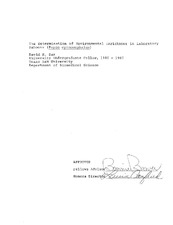| dc.contributor.advisor | Beaver, Bonnie | |
| dc.creator | Sax, David M. | |
| dc.date.accessioned | 2022-04-01T15:05:05Z | |
| dc.date.available | 2022-04-01T15:05:05Z | |
| dc.date.issued | 1987 | |
| dc.identifier.uri | https://hdl.handle.net/1969.1/CAPSTONE-SaxD_1987 | |
| dc.description | Program year: 1996/1997 | en |
| dc.description | Digitized from print original stored in HDR | en |
| dc.description.abstract | The purpose of this investigation was to determine the effects of rope pulling for a food reward as a method of environmental enrichment in laboratory baboons, measured by activity where cage size is limited and the animals are housed individually.
The investigation used six adult female baboons (Papio cyinocephalus) housed in one of two environments differing with regard to size. One style of cage had the dimensions 4' X 3' X 4', while the alternative design had the dimensions 8' X 4' X 8'. Prior to the investigation, each baboon was monitored using time lapse video tape equipment, such that a twenty-four consecutive hour period of activity was recorded to serve as a control. Following this initial taping, each baboon was conditioned to pull a rope for a food reward. Eventually, the animals would have to move to pull the rope and move again to receive the reward. Each animal was conditioned fifteen minutes per day for a total of for weeks. A second video taping followed the conditioning procedure using the same guidelines as the first taping.
Data was recorded based on the baboon's activity durations and locations to the nearest one minute of duration. Averages were obtained for pre- and post-conditioned animals of both groups. Comparisons were made between the same group as well as between differing groups.
The results indicated that activity levels in the large caged group increased significantly (P < .05). In addition, the large caged animals displayed a greater degree of variability in both activity distribution and intensity regardless of conditioning. This may indicate that cage size alone has an effect upon behavior.
The rope pulling was an easily taught behavior and was received well by the baboons, as indicated by their motivation to manipulate it. This device has good potential as a self feeder and may become an effective environmental enrichment technique used to promote the psychological well being of primates. | en |
| dc.format.extent | 50 pages | en |
| dc.format.medium | electronic | en |
| dc.format.mimetype | application/pdf | |
| dc.subject | baboons | en |
| dc.subject | environmental enrichment | en |
| dc.subject | cage size | en |
| dc.subject | psychological well being | en |
| dc.title | The Determination of Environmental Enrichment in Laboratory Baboons (Papio cyinocephalus) | en |
| dc.title.alternative | The Determination of Environmental Enrichment in Laboratory Baboons (Papio cyinocephalus) | en |
| dc.type | Thesis | en |
| thesis.degree.department | Biomedical Science | en |
| thesis.degree.grantor | University Undergraduate Fellow | en |
| thesis.degree.level | Undergraduate | en |
| dc.type.material | text | en |


